Summary
Summary CS114 - 2.1 Defining Functions
- Course
- Computer Science 114 (CS114)
- Institution
- Stellenbosch University (SUN)
Summaries based on Chapter 2.1 from the "Introduction to Programming in Java" textbook to assist in revising for the CS114 tests & exams. For much lower prices, have a look at the bundle of notes for several chapters. More summaries will be added soon :)
[Show more]













